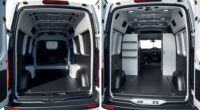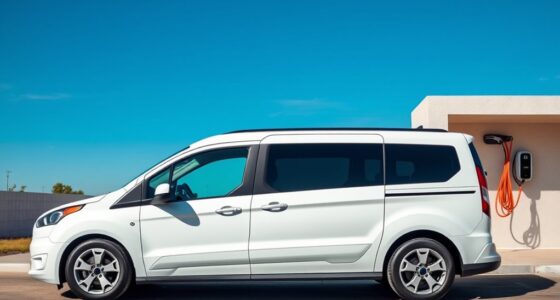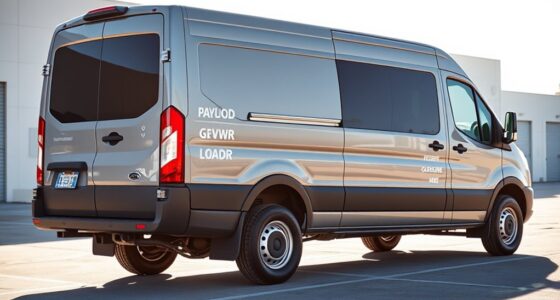Your Ford E‑Transit’s range depends heavily on payload weight, temperature, and driving habits. Carrying a heavy load increases energy use, reducing miles you can travel, especially in cold weather where battery efficiency drops. Fast driving, abrupt stops, and hilly routes also drain your battery faster. To maximize range, keep loads light, drive smoothly, and monitor temperatures closely. For more tips on managing these factors and getting the most from your E‑Transit, keep exploring further.
Key Takeaways
- Payload weight reduces range by approximately 10-15%, especially when near maximum GVWR.
- Cold temperatures (below 40°F) can decrease battery efficiency and range by 10-18%.
- Proper preconditioning while plugged in helps maintain battery performance in cold weather.
- Gentle driving, moderate speeds (~65 mph), and smooth acceleration extend vehicle range.
- Accessories like roof racks and larger tires increase weight and drag, lowering overall range.
Understanding Payload Capacity and Its Impact on Range
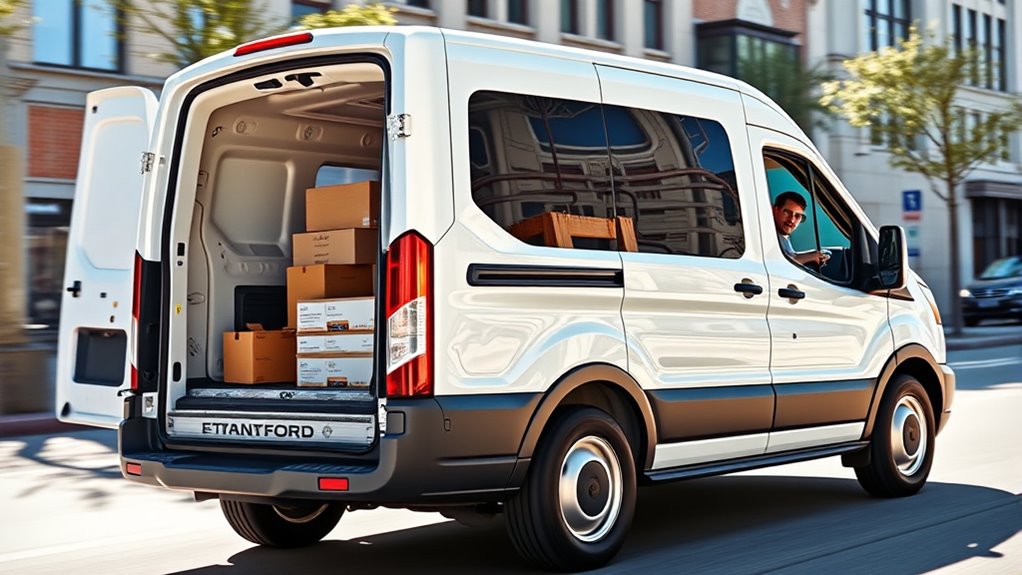
Have you ever wondered how carrying a full load affects your Ford E‑Transit’s driving range? When your van is fully loaded, it can reduce your range by about 25% or more. The E‑Transit’s maximum payload capacity ranges from 3,800 to over 4,300 pounds, depending on the configuration. Real-world tests with near-maximum payloads—around 2,962 pounds plus passengers—show a drop in range from roughly 126 miles to about 95 miles. Payload weight significantly impacts electric vehicle efficiency, Heavier payloads require more energy to move, lowering efficiency by roughly 10-15%. Unlike internal combustion vehicles, electric models like the E‑Transit see a more significant impact from payload weight. Proper load distribution and adhering to gross vehicle weight ratings are essential to maintain ideal range and safety. Recognizing the importance of load management can help maximize your vehicle’s range and performance. Additionally, electric vehicle efficiency can be further optimized by adopting smooth driving styles and maintaining proper tire pressures. Moreover, understanding vehicle aerodynamics and how it interacts with payload can contribute to better range management.
How Vehicle Weight and Battery Size Affect Driving Distance
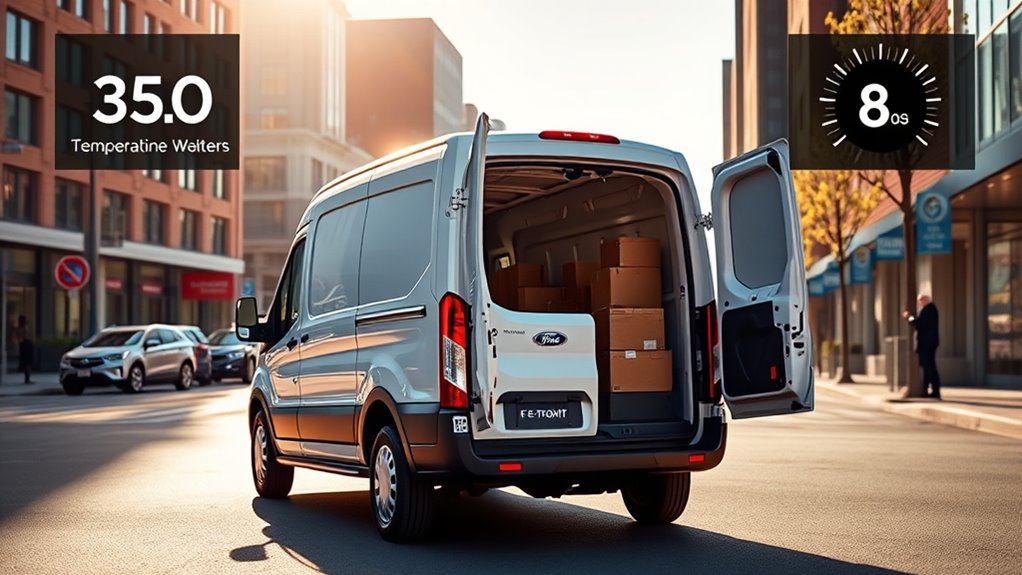
Your vehicle’s weight and battery size directly influence how far you can drive on a single charge. A heavier van consumes more energy, especially with larger payloads, which reduces your range. Meanwhile, choosing a bigger battery can boost distance but adds weight that also impacts efficiency. Battery capacity impacts overall range, and selecting the right balance depends on your specific needs and driving conditions. Additionally, external factors such as Tesla Fire Incidents can influence vehicle safety and performance over time.
Battery Weight and Range
The size of the battery in the Ford E-Transit directly influences its driving range, but increasing battery capacity also adds weight to the vehicle. A larger battery, like the 89 kWh variant, boosts range to about 402 km WLTP, up from 316 km with the 68 kWh pack. However, the added weight, ranging from around 6,189 to 6,635 pounds, increases energy consumption due to higher rolling resistance and inertia. Heavier batteries elevate the vehicle’s curb weight, which can reduce efficiency and cause higher energy use during acceleration and hill climbs. Although advanced thermal management and higher motor power support heavier configurations, the increased weight diminishes some of the range benefits. Balancing battery size and weight is key to optimizing both range and vehicle performance. Weight distribution also plays a critical role in overall vehicle handling and efficiency. Additionally, the vehicle’s aerodynamics can influence how weight impacts overall range and efficiency. Moreover, considering the impact of vehicle weight on efficiency can help in making informed choices about battery options and vehicle setup.
Vehicle Payload Limitations
Vehicle weight, especially when considering payload and battery size, directly impacts the driving distance of the Ford E-Transit. Heavier loads increase energy consumption, reducing range. For example, max payloads range from 790 kg in the 3.5-tonne model to 1,758 kg in the 4.25-tonne version. Larger batteries add kerb weight, lowering payload capacity to stay within GVW limits. Proper load distribution is essential for safety and handling, as exceeding axle ratings can cause damage or unsafe driving. The table below summarizes payload, kerb weight, and GVW relationships: Water Parks can be a fun way to stay cool during hot weather, especially when traveling to areas like Jacksonville or Wisconsin Dells. Additionally, understanding the impact of vehicle weight on overall efficiency can help optimize your vehicle’s performance and longevity. Being aware of vehicle weight limitations ensures you stay within safe operating parameters and maximize the effectiveness of your vehicle’s range.
Weight Impact on Efficiency
Increasing payload weight directly affects the efficiency of the Ford E-Transit by raising energy consumption and shortening driving range. When you add weight through payload or modifications, the vehicle faces more resistance, requiring more battery power to move. Tests show that a fully loaded E-Transit (near 9,500 lbs GVWR) can deliver about 80 to 90 miles per charge, compared to over 120 miles when empty or lightly loaded. This range loss can be around 18% under full payload conditions. Heavier loads accelerate battery depletion, especially in stop-and-go driving or demanding routes. Keep in mind that larger batteries offer more range but are offset by additional weight. As a result, payload and added equipment considerably influence your vehicle’s efficiency and driving distance. Additionally, understanding electric vehicle design principles can help optimize load distribution for better performance, which is especially important when considering battery weight and its impact on overall efficiency. Proper weight management can also mitigate energy consumption, leading to more consistent driving distances and better vehicle longevity.
The Effect of Payload on Energy Consumption and Range

When you load the Ford E‑Transit heavily, you’ll notice its energy consumption increases, reducing your driving range. The higher payload makes the motor work harder, especially at maximum capacity, leading to more frequent recharges. Understanding how payload limits impact range helps you plan routes and deliveries more effectively. Additionally, adhering to efficient general ledger coding practices can streamline maintenance and operational costs associated with managing fleet data. Recognizing how effective payload management influences overall vehicle performance can further optimize your fleet’s efficiency. Being aware of cost and budgeting principles can also help you allocate resources wisely for maintenance and upgrades.
Heavier Loads Increase Consumption
Carrying heavier loads substantially impacts the energy consumption and range of an E-Transit van. When you load more cargo, the vehicle needs extra power to accelerate, maintain speed, and stop, which increases energy use. As a result, the real-world range can drop by about 10% to 20%. For example, with a payload near 3,000 pounds, the E-Transit’s range can decrease by roughly 18%, often delivering around 95 miles at highway speeds instead of the rated 116 miles. Heavier loads also raise rolling resistance and inertia, making the drivetrain less efficient. This means you’ll use more battery energy to cover the same distance. Proper vehicle maintenance and adjusting driving style can help mitigate some of these efficiency losses. Overall, heavier payloads considerably reduce your van’s range, especially when combined with other factors like speed and temperature.
Payload Limits Affect Range
Payload limits directly influence your E-Transit’s range by affecting how much energy the vehicle consumes during operation. When you carry near the maximum GVWR of 9,500 lbs, your range drops considerably compared to lighter loads. Tests with payloads close to this limit, including nearly 4,000 lbs of rubber mats, showed a decrease from 116 miles to about 95.2 miles. Heavier loads increase energy demand, reducing miles per kWh and overall efficiency. Environmental factors like cold weather and speed further compound this effect. The table below highlights how payload weight and conditions impact range:
| Payload Condition | Approximate Range | Efficiency (miles per kWh) |
|---|---|---|
| Half-payload | 116 miles | 1.8 miles |
| Full payload | 95 miles | 1.4 miles |
| Cold weather | -18% range loss | – |
| Max payload load | Mid-80s miles | – |
| Ideal conditions | 116 miles | – |
Additionally, understanding the energy consumption factors, such as payload and environmental conditions, is essential for optimizing your vehicle’s performance and range. Properly managing these factors can help maximize your vehicle’s range efficiency, especially under varying operational circumstances. Being aware of cybersecurity vulnerabilities, such as potential data breaches or hacking risks, is also crucial when managing connected fleet vehicles.
Temperature Variations and Their Influence on Battery Efficiency
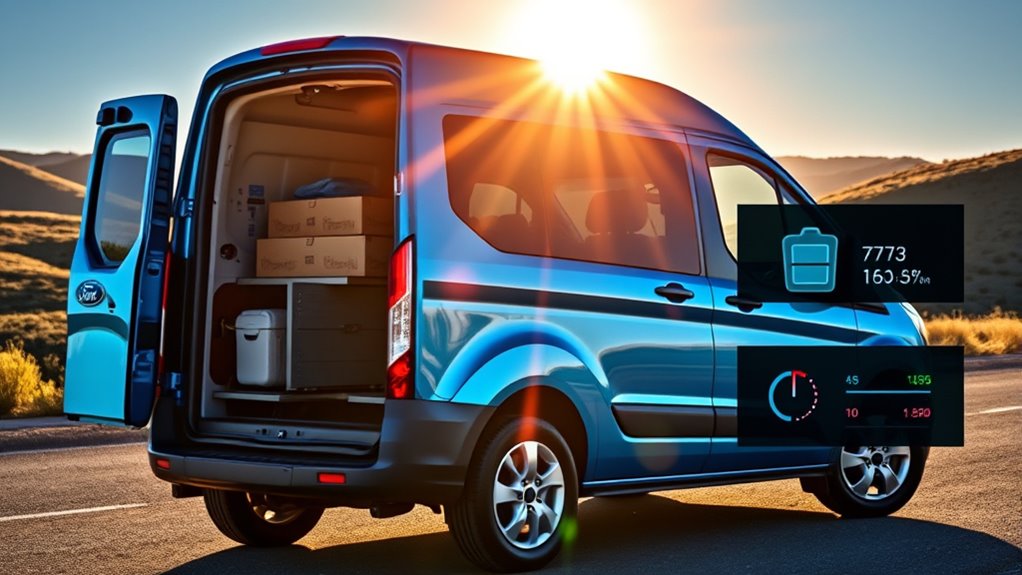
Temperature variations considerably impact the battery efficiency of the Ford E‑Transit, as its performance relies on maintaining an ideal ambient temperature. When temperatures fall below or rise above about 70°F (20–25°C), your battery’s energy capacity drops, reducing range. At 14°F (-10°C), preconditioning helps you retain around 75% of your range, but without it, efficiency drops to about 66%. The heat pump system, like Ford’s VIHP, recovers ambient heat to warm the cabin efficiently, conserving battery power. Proper preconditioning before departure and using targeted heating features help you keep your battery within suitable temperature ranges, maximizing range and performance despite temperature fluctuations. The integration of advanced heat pump technology significantly helps maintain optimal battery temperatures in varying climates. Additionally, understanding battery thermal management systems can further optimize your vehicle’s efficiency in different weather conditions, especially with temperature regulation strategies tailored for electric vehicles.
Cold Weather Challenges and Range Reduction Strategies

Cold weather poses significant challenges for your Ford E‑Transit, primarily by reducing the battery’s chemical activity and limiting available energy. This causes your range to drop by about 10-18%, especially around 20–40°F. To combat this, preconditioning your vehicle while plugged in helps warm the battery and cabin, reducing energy use during your drive. Using seat and windshield heaters instead of full cabin heating conserves energy. Engaging regenerative braking recaptures energy, extending range. Keep accessories like lights and electronics to a minimum, especially on shorter days. Maintaining proper tire pressure and vehicle maintenance also helps improve efficiency. Remember, running maximum cabin heat can cut your range by more than half, so smart heating strategies are key to managing cold-weather impacts.
Driving Style: Optimizing Efficiency for Maximal Range
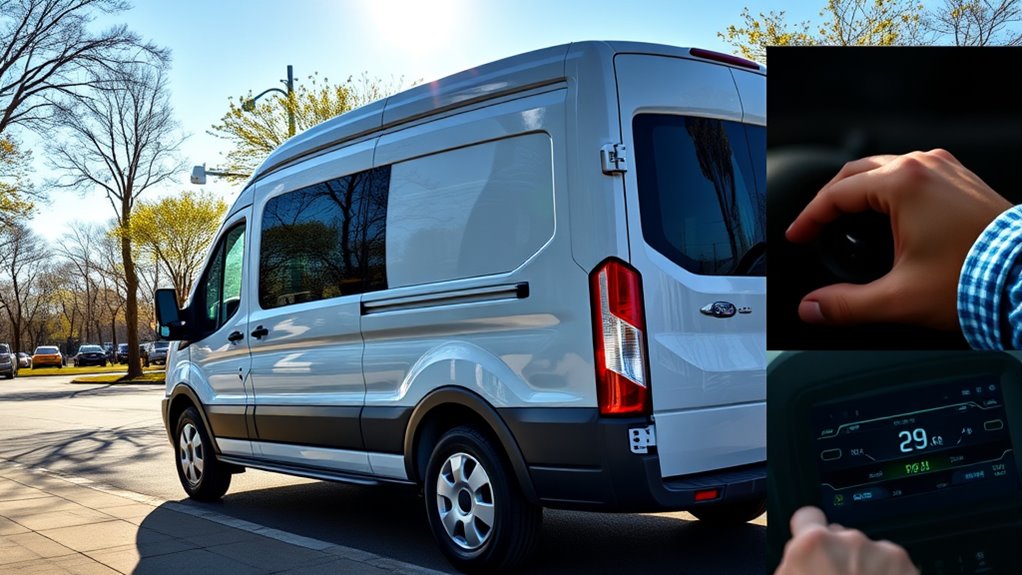
Optimizing your driving style is essential to maximize the range of your Ford E‑Transit. Choosing eco-friendly drive modes, like Eco Mode, can substantially extend your battery life by prioritizing efficiency over raw power. Limiting rapid acceleration and avoiding aggressive starts help preserve energy, while steady, moderate acceleration is more efficient. Using regenerative braking captures energy during deceleration, adding to your range. Speed management also matters—driving at moderate speeds and using cruise control reduces aerodynamic drag and energy spikes. To make the most of your range, consider these strategies:
Maximize your Ford E‑Transit range with smooth driving, eco modes, and steady speeds.
- Select Eco Mode and manual drive adjustments for route and load conditions.
- Practice smooth acceleration and deceleration to prevent energy waste.
- Maintain consistent speeds and avoid sudden changes to conserve power.
- Implementing these driving techniques can help you take full advantage of the vehicle’s Extended Range and Charging Performance, ensuring you get the maximum mileage from each charge.
The Role of Smooth Driving and Speed Management
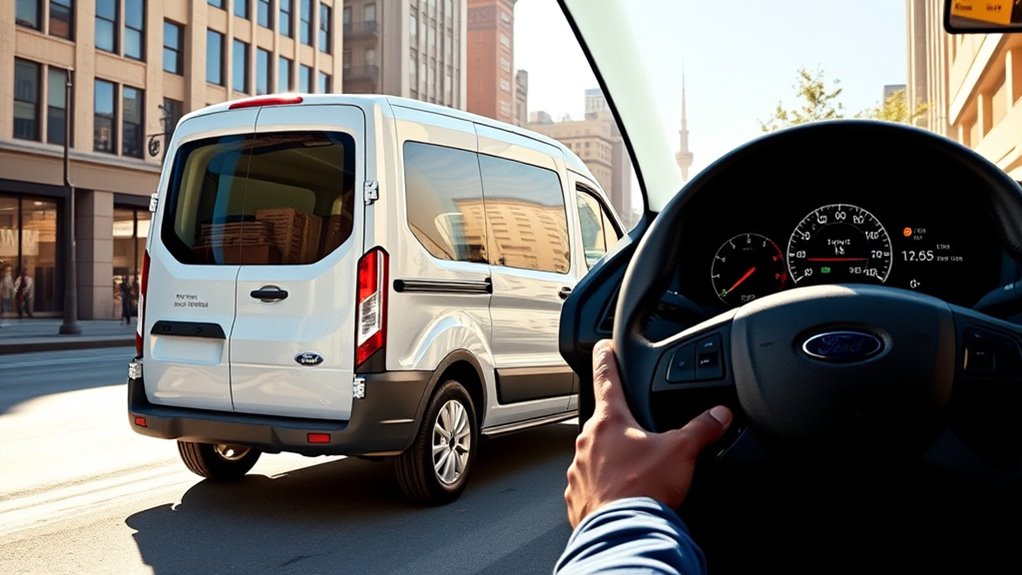
Smooth driving and effective speed management are key to maximizing your Ford E‑Transit’s range. By accelerating gradually and avoiding abrupt throttle inputs, you reduce energy waste and keep the battery healthier. Maintaining moderate speeds, around 65 mph, minimizes aerodynamic drag and energy consumption, while driving faster—75 mph or more—can cut your range by up to 22%. Using regenerative braking with one-pedal driving in stop-and-go traffic helps recover energy and decreases brake wear. Anticipating traffic flow and terrain allows you to adjust your speed seamlessly, avoiding unnecessary acceleration and deceleration. Consistent, predictable driving not only conserves battery power but also ensures more accurate range estimates. Ultimately, managing your speed and driving smoothly optimize energy efficiency and extend your Ford E‑Transit’s driving range.
Accessories and Configuration Choices That Impact Range
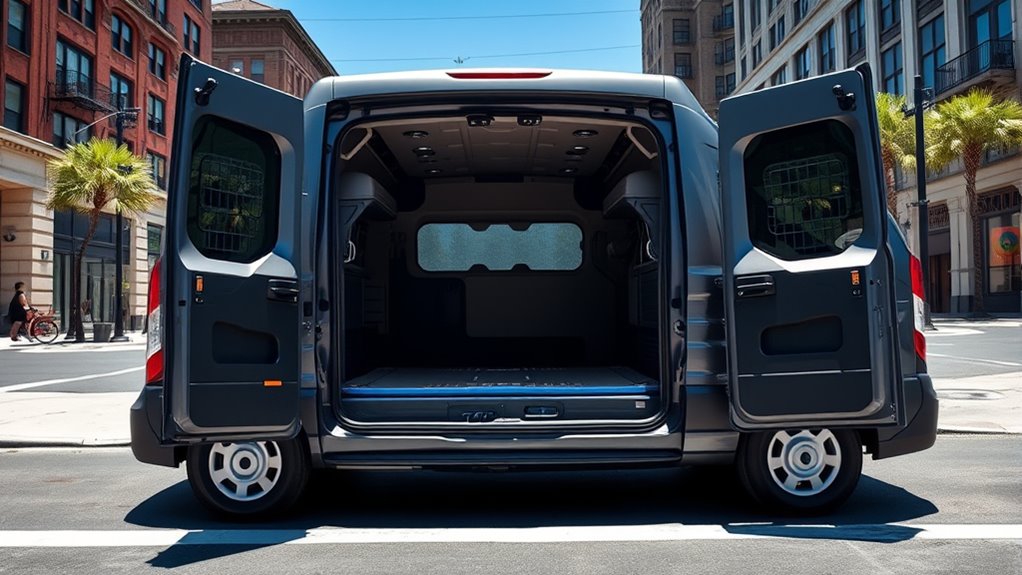
Choosing the right accessories and vehicle configuration can substantially influence your Ford E‑Transit’s range. Extra add-ons like roof racks, ladders, and external lighting increase weight and aerodynamic drag, reducing efficiency. Upgraded wheels and larger tires can also raise rolling resistance, impacting mileage. The vehicle’s internal layout and installed systems—such as safety packages or technology features—add weight and can draw more power. Larger or taller configurations, like high roofs or extended lengths, tend to decrease range due to increased weight and drag. Even aesthetic touches, like chrome accents, can have a minor but noticeable effect. Being mindful of these choices helps you optimize your van’s efficiency without sacrificing functionality or style. According to recent tests, adding heavy accessories can decrease range by up to 15%. – Minimize bulky accessories to preserve range – Opt for lower, streamlined configurations – Choose lightweight, efficient wheels and tires
Practical Tips to Maximize Your Ford E-Transit’s Range

Maximizing your Ford E-Transit’s range involves smart driving habits and vehicle management. Start by choosing Eco Mode to reduce acceleration and improve efficiency. Use “L” drive mode for regenerative braking, recovering energy during deceleration. Maintain moderate speeds and smooth acceleration to save battery power. Minimize harsh braking and unnecessary stops. Precondition the vehicle before departure to conserve battery. During winter, warm the cabin with recirculated air and park in sheltered areas to reduce cold-related range loss. Be mindful of payload; avoid overloading and ensure proper tire inflation. Route planning helps avoid hills and traffic, optimizing energy use.
| Driving Technique | Benefits |
|---|---|
| Eco Mode | Longer range |
| Regenerative Braking | Energy recovery |
| Moderate Speeds | Reduced consumption |
| Preconditioning | Battery preservation |
Frequently Asked Questions
How Does Roof Height Affect the Vehicle’s Aerodynamics and Range?
You’ll notice that roof height substantially impacts your vehicle’s aerodynamics and range. Taller roofs increase the frontal area, causing more air resistance and turbulence, especially at highway speeds. This extra drag reduces your driving range, with high-roof models typically covering less distance than low-roof versions. So, if you want maximum range, opting for a lower roof can help minimize drag and make your trips more efficient.
What Is the Impact of Accessory Weight on Payload Capacity and Range?
Accessory weight acts like a silent storm, eroding your payload capacity and draining your range. Each added item weighs down your vehicle, shrinking your cargo space and forcing your battery to work harder. You’ll notice reduced efficiency, slower acceleration, and shorter distances per charge. To keep your journey smooth and safe, weigh accessories carefully, stay within limits, and adjust your load—because every extra pound whispers a toll on performance and range.
How Does Driving in Hilly Terrain Influence Energy Consumption?
Driving in hilly terrain increases your energy consumption because climbing steep grades demands more power, which drains the battery faster. You’ll notice reduced range on routes with frequent elevation changes, especially if you accelerate aggressively or drive at higher speeds. To maximize efficiency, maintain moderate speeds, drive smoothly, and use regenerative braking downhill to recover energy. Planning routes with gentler slopes helps preserve your vehicle’s range and overall performance.
Can Tire Pressure Adjustments Improve Electric Range?
Tire pressure tweaks can truly boost your EV’s efficiency. By maintaining proper pressure, you reduce rolling resistance, which means your motor works less and your range extends. Underinflated tires increase energy drain, while overinflation can compromise traction. Regularly checking and adjusting your tires within Ford’s recommended guidelines keeps your transit running smoothly, saving energy and extending your electric expedition’s endurance. Keep tires tuned for peak performance and maximum mileage.
How Does Regenerative Braking Efficiency Vary With Load and Driving Style?
Regenerative braking efficiency improves as your load increases because heavier payloads generate more kinetic energy to recover during deceleration. Your driving style also matters; smooth, gradual brake taps maximize regen, while abrupt stops shift more energy to friction brakes, reducing efficiency. By modulating your braking gently and carrying appropriate loads, you can optimize energy recovery, extending your vehicle’s range and making the most of regenerative braking.
Conclusion
To get the most out of your Ford E-Transit, remember that understanding how payload, temperature, and driving habits affect range is key. Keep your vehicle light, drive smoothly, and plan for weather conditions to stretch your battery life. Don’t let small tweaks go unnoticed—they can make a big difference. After all, a little effort goes a long way, helping you stay ahead of the curve and avoid surprises on the road.

